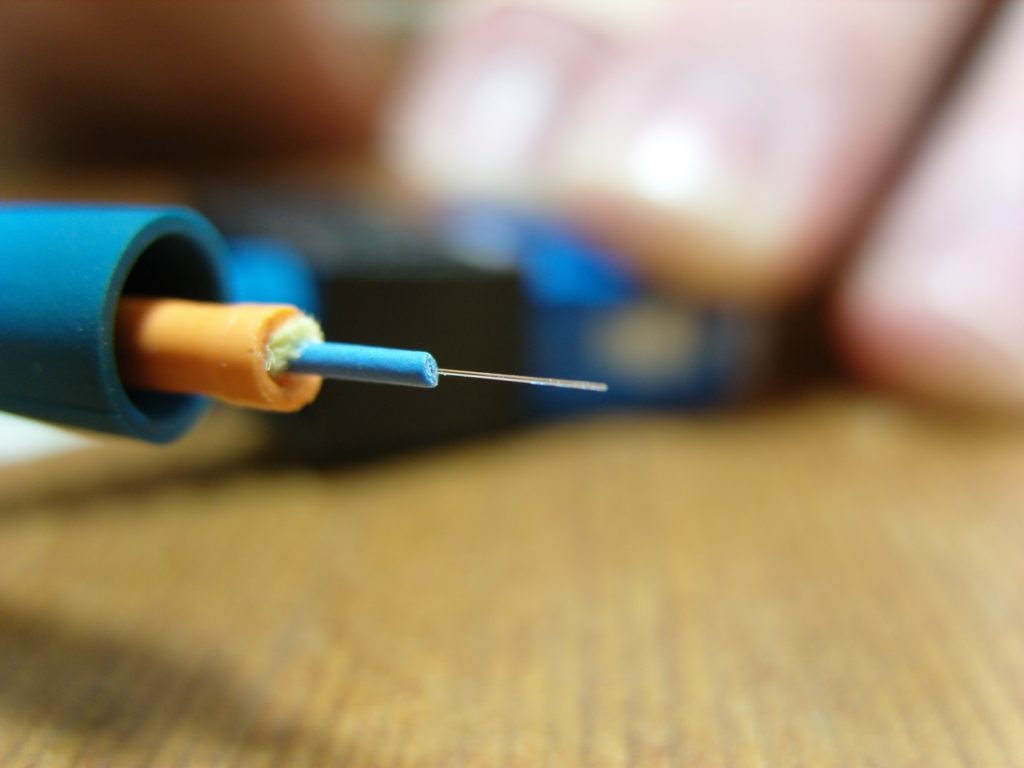July 21, 2016
Fiber optic cables have been more and more widely used in all kinds of applications. You can use fiber optic jumper cables to connect end devices or network hardware to the structured cabling system and one popular type of fiber optic jumper cables, MPO cable, is a good solution for your high density applications. The technique to handle optical fiber can have a significant impact on the functionality and reliability of a fiber optic cable. The cost of rework or replacement due to improper handling can also be significant and may cause monetary losses and increased processing times. In this post, several suggestions will be given for proper handling of optical fiber during the design and implementation of a fiber handling program specific to a user's application and manufacturing process.

Before illustrating the suggestions for proper handling of optical fibers, a few kinds of fiber damage will be introduced, which are compressive damage, abrasive damage, fatigue damage and particulate penetration.
Compressive damage may occur when a fiber is pinched, clamped, or constrained to a point where the coating or glass layers become damaged. This can result in several effects depending on the severity of the compressive force, including coating delamination, coating damage (splits, cracks), and strength degradation due to the introduction of flaws onto the glass surface.
Abrasive damage may occur when a fiber comes into sliding contact with a sharp object such that it is scratched or scraped. This may result in damage of the polymeric coating or removal of it from the fiber. And it is also probably that the contact will damage the glass surface of the fiber, creating flaws that reduce the fiber's strength.
Fatigue damage is defined as the slow extension of a flaw over time due to the application of a tensile stress in the presence of moisture or humidity. The implication of fatigue is that a fiber may degrade in strength over time if placed under a considerable stress, which could be in form of a pure tensile, bending, or torsional stress, or any combination thereof.
Particulate penetration occurs when a hard particle, such as glass or ceramic, penetrates the coating layer of a fiber. This can often be initiated due to poor process cleanliness, and exacerbated by static electricity and subsequent processing.
To avoid those four kinds of fiber damages mentioned above as much as possible, there are corresponding practices.
- Never place tools, fixtures, or components on top of an optical fiber.
- Do not over-tighten objects used to constrain optical fiber.
- Avoid the use of tweezers or other such tools to handle optical fiber.
- Never allow a fiber to contact an uncontrolled surface where it may be stepped upon, rolled over with a chair castor, etc.
- If fiber is clamped during processing, ensure that the clamping pressure is limited so that damage is not induced. Any clamping materials that physically contact the fiber should be smooth, pliable and nonabrasive.
- Do not allow optical fiber to contact sharp or jagged edges or work surfaces.
- Take care with fingernails and jewelry when handling optical fiber.
- Never wipe an optical fiber with an abrasive material or with organic solvents such as acetone.
- Never allow an optical fiber to contact an uncontrolled surface where it may become snagged or otherwise abraded.
- Regularly check any pulleys or other hardware that the fiber may contact for nicks, burrs, corrosion, etc. All surfaces should be smooth and free of any debris or defect.
Always follow the recommended applied stress design guidelines for optical fiber. Generally, these rules dictate that an optical fiber should not be subjected to a stress higher than one-half the proof stress for a time on the order of one second, and to no more than one-third the proof stress for a time on the order of four hours.
- Clean all surfaces that contact the optical fiber regularly.
- Ensure that any bins or receptacles used to hold or contain fiber are free of debris.
- Never allow an optical fiber to contact an uncontrolled or dirty surface where it may contact particulate material.
- Check pulleys, work surfaces and other hardware regularly for the presence of corrosion or other contamination.
- Control static electricity, which may reduce fiber tangles, as well as attraction of particulate to the fiber.
- Do not cut or break optical fibers directly over work surfaces, which creates high stress fracture and may release numerous microscopic shards of glass over the work surface.
Proper handling of optical fiber can help you save a lot of money. These suggestions to reduce occurrences of fiber damage or breakage are applicable to a wide range of processes and applications. To create a functional and reliable product utilizing optical fiber, you can follow these guidelines in your handling and processing procedures.
Posted by: jowang at
08:01 AM
| No Comments
| Add Comment
Post contains 822 words, total size 7 kb.
35 queries taking 0.0189 seconds, 70 records returned.
Powered by Minx 1.1.6c-pink.









